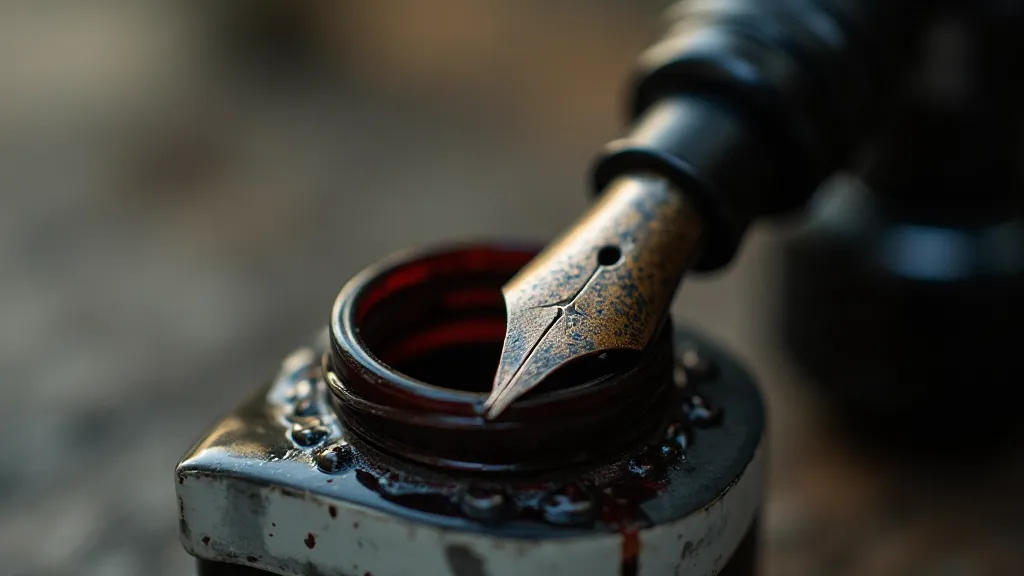Quill & Crucible: The Alchemical Transformation of Ink into Narrative
The scent of antique paper, the feel of cool metal in your hand, the gentle scratch of a nib against the page – these are more than tactile sensations. They are echoes of a time when writing was a deliberate act, a ritual almost. Owning and appreciating antique pens isn’t just about possessing a beautiful object; it’s about touching a lineage of creativity, a tangible connection to the stories that have shaped our world. It’s about understanding the slow, considered process of transforming simple elements into something profound.
Consider the origins of ink itself. The word "alchemy" often conjures images of gold transmutation, but the earliest alchemists were fundamentally concerned with color – with extracting dyes and pigments from natural sources. Early inks were brutal things: soot mixed with gum arabic, gall nuts steeped to release their tannins, iron salts reacting with vegetable matter. The process wasn’t precise. Results varied based on the season, the soil, the skill of the maker. This inherent variability mirrors the creative process itself – the unpredictable confluence of inspiration, experience, and technique that yields a unique and often surprising outcome.

The Rise of the Pen Makers: More Than Just Mechanics
As inks became more standardized, the focus shifted to the instruments that delivered them. From the quill pen, meticulously carved from goose or swan feathers, to the early steel nibs, each innovation represented a refinement of the process. But the real flowering of pen making occurred in the late 19th and early 20th centuries, a period fueled by industrialization and a burgeoning middle class eager for elegant writing tools. This era witnessed the birth of iconic brands, names that still resonate with collectors today.
Take, for instance, Waterman's. Established in Paris in 1884 by Louis-Oscar Waterman, the company revolutionized fountain pen design with its “capillary feed” system, ensuring a consistent ink flow. Waterman's pens weren't simply functional; they were symbols of sophistication and progress. They adorned the desks of diplomats, novelists, and businessmen, shaping correspondence and documenting history. Examining a Waterman's pen – the weight of the gold fill, the intricate engraving – you can almost feel the weight of expectation, the seriousness of purpose that accompanied its use.
Then there's Sheaffer, founded in Fort Wayne, Indiana, in 1908 by Walter A. Sheaffer. Sheaffer’s early innovations like the “lever filler” and “vacumatic filler” were strokes of genius in engineering and design, making fountain pens more accessible and user-friendly. Their pens reflected the optimism and ambition of a rapidly growing nation. They weren’t just writing instruments; they were statements of success, embodiments of the American dream. I recall finding a Sheaffer Lifetime Balance in a dusty antique shop years ago. The deep burgundy color, the satisfying click of the lever – it felt like holding a small piece of history, a tangible link to a bygone era.
L. Waterman & Son: The Parisian Legacy
The Parisian craftsmanship of L. Waterman & Son deserves particular attention. Their pens were renowned not just for their innovative filling mechanisms but for their aesthetic beauty, the elegance of their lines, and the meticulous attention to detail. Many Waterman's pens of this period featured intricate engine-turned patterns and elaborate gold accents, showcasing the skill of the artisans who crafted them. They weren’t mass-produced objects; they were works of art, testaments to the enduring power of French design. The firm’s reputation wasn't solely built on engineering prowess; it was forged in the fires of an uncompromising commitment to quality and style. Imagine the countless letters, the declarations of love, the business proposals – all penned with Waterman's ink flowing across the page, each stroke infused with the Parisian spirit.

Parker: The Democratization of Elegance
Parker, established in 1888 by George S. Parker, took a different approach. While other brands catered to a more exclusive clientele, Parker sought to democratize elegance, making fine writing instruments accessible to a wider audience. Their "Lucky Pencil" quickly gained popularity, and their later innovations, like the button filler and the Aerometric ink system, were both ingenious and reliable. Parker pens were the writing instruments of choice for generations, gracing the desks of students, teachers, and professionals alike. The ubiquity of Parker pens is a testament to their enduring appeal and their ability to connect with people on a personal level.
Sheaffer: A Touch of American Flair
Sheaffer’s story is also compelling. From humble beginnings, the company grew into an industry powerhouse. Their design aesthetic often reflected American optimism and ingenuity, often bolder and more decorative than their European counterparts. This isn's to say European pens were inferior, but rather that American design embraced a different kind of expressiveness, one that celebrated innovation and individuality. Restoring a vintage Sheaffer often reveals the meticulous engineering beneath the surface, a tangible representation of the ingenuity that defined the era.
The Alchemical Connection: Beyond the Object
Owning an antique pen isn’t just about owning an object; it's about participating in a ritual, a continuation of a lineage. As you hold the pen, feel the weight of history in your hand, imagine the countless stories it has witnessed. Consider the alchemical transformation – the raw materials transformed into ink, the ink delivered by the pen, the pen used to create something new. The process is a metaphor for creativity itself: the seemingly disparate elements of experience, observation, and imagination combining to produce something meaningful and enduring.
The condition of many antique pens isn't pristine. Nibs may be damaged, filling mechanisms may be temperamental, and celluloid may be cracked. These imperfections, however, are part of the pen’s story. They are marks of time, evidence of use. They remind us that these were tools, not museum pieces, and that they were used to create something of value. Learning to repair a vintage pen – cleaning the nib, adjusting the feed, replacing a cracked lever – isn’t just a mechanical task; it’s an act of preservation, a way of honoring the craftsmanship of the past.

Preserving the Narrative
The world has moved on from the elegance and formality of handwritten correspondence. But the legacy of these antique pens remains. They represent a time when writing was a deliberate act, a moment of connection, a way of preserving memories and sharing ideas. By collecting, restoring, and appreciating these beautiful objects, we keep that narrative alive, ensuring that the stories they helped to create continue to inspire generations to come.





